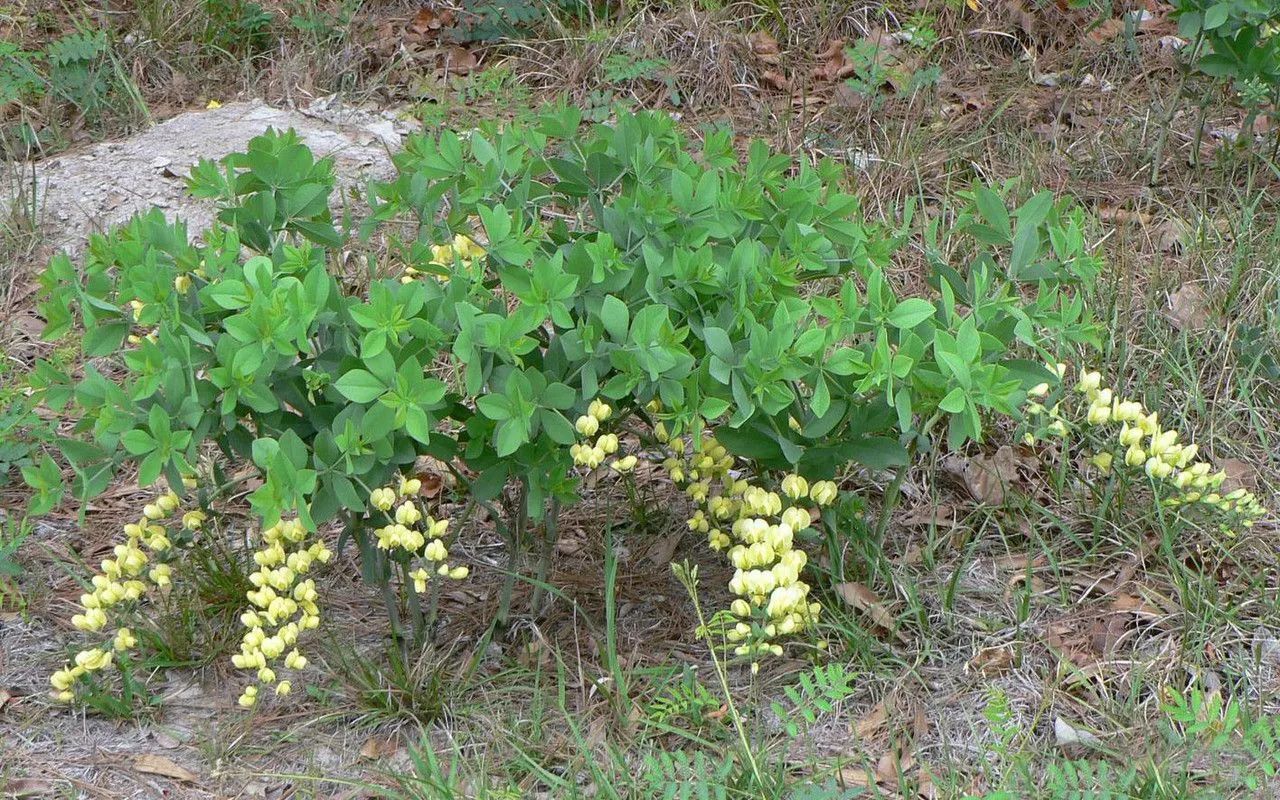
Author: Muhl. ex Elliott
Bibliography: Sketch Bot. S. Carolina 1: 469 (1817)
Year: 1817
Status: accepted
Rank: species
Genus: Baptisia
Vegetable: False
Observations: C. & SE. U.S.A.
Longbract wild indigo, scientifically known as Baptisia bracteata, is a fascinating perennial herb native to the central and southeastern regions of the United States. This member of the Fabaceae family was first described in the early 19th century, with its botanical nuances detailed in “Sketch Botany of South Carolina” in 1817 by Elliott, based on the observations of Muhlenberg.
This plant thrives in open woodlands and prairies, where it displays its vibrant flowering spikes each spring. The blossoms are typically creamy yellow, arranged in dense, elongated racemes that gracefully droop, providing a striking visual against its lush, green foliage. The plant’s name, ‘Longbract,’ refers to the extended bracts (leaf-like structures) that accompany the flowers, adding to its ornamental appeal.
Longbract wild indigo is highly esteemed not only for its beauty but also for its ability to improve soil health. As a legume, it engages in a symbiotic relationship with nitrogen-fixing bacteria, enhancing the fertility of its habitat. This ecological role underscores its importance in native plant gardens and restoration projects aimed at sustaining local biodiversity.
Garden enthusiasts treasure Baptisia bracteata for its hardiness and minimal maintenance requirements. Once established, it is drought-tolerant and resistant to most pests and diseases. Its deep root system also makes it an excellent choice for erosion control. Typically blooming in late spring, it attracts a variety of pollinators, including bees and butterflies, contributing to a lively and healthy garden ecosystem.
In conclusion, Baptisia bracteata, or longbract wild indigo, is a remarkably resilient and aesthetically pleasing plant with significant ecological benefits. Its historical documentation and continued presence in the wild speak volumes about its adaptability and integral role in the natural landscapes of the central and southeastern United States.
Eng: plains wild indigo, longbract wild indigo
En: Longbract wild indigo, Plains wildindigo, Plains wild indigo
Ml: ബാപ്റ്റിസിയ ബ്രക്റ്റേറ്റ
Taken Mar 7, 2016 by EOL − anewman (cc-by-nc)
Taken Apr 5, 2016 by EOL − Greg Lasley (cc-by-nc)
Taken Mar 7, 2016 by EOL − anewman (cc-by-nc)
Taken Apr 15, 2022 by christina mueller (cc-by-sa)
Taken Jan 1, 1900 by EOL − Frank Mayfield (cc-by-sa)
Taken Jun 2, 2020 by Aaron Harp (cc-by-sa)
Taken Apr 20, 2011 by EOL − Ron Thomas (cc-by-nc-sa)
Taken Apr 20, 2011 by EOL − Ron Thomas (cc-by-nc-sa)
Taken Jan 1, 1900 by EOL − Larry Trekell, Bugwood.org (cc-by)
Taken Apr 12, 2016 by EOL − hgoodman30 (cc-by-nc)
Taken Apr 11, 2016 by EOL − hgoodman30 (cc-by-nc)
Taken Apr 5, 2016 by EOL − Greg Lasley (cc-by-nc)
Taken Apr 28, 2007 by EOL − Ron Thomas (cc-by-nc-sa)
Taken Apr 20, 2011 by EOL − Ron Thomas (cc-by-nc-sa)
Taken Apr 20, 2011 by EOL − Ron Thomas (cc-by-nc-sa)
Taken Nov 12, 2013 by EOL − Daniel Carter (cc-by-nc)
Taken Jan 1, 1900 by EOL − John Hilty (cc-by-nc)
Taken Apr 28, 2007 by EOL − Ron Thomas (cc-by-nc-sa)
Taken Aug 12, 2008 by EOL − Frank Mayfield (cc-by-sa)
Taken Jan 1, 1900 by EOL − Gerrit Davidse (cc-by-nc-sa)
Taken Jan 1, 1900 by EOL − Encyclopedia of Life (public)
Taken Apr 28, 2007 by EOL − Ron Thomas (cc-by-nc-sa)
Growth habit>: Forb/herb
Family: Myrtaceae Author: (F.Muell.) K.D.Hill & L.A.S.Johnson Bibliography: Telopea 6: 402 (1995) Year: 1995 Status:…
Family: Rubiaceae Author: Pierre ex A.Froehner Bibliography: Notizbl. Bot. Gart. Berlin-Dahlem 1: 237 (1897) Year:…
Family: Sapindaceae Author: Koidz. Bibliography: J. Coll. Sci. Imp. Univ. Tokyo 32(1): 38 (1911) Year:…
Family: Asteraceae Author: A.Gray Bibliography: Pacif. Railr. Rep.: 107 (1857) Year: 1857 Status: accepted Rank:…
Family: Fabaceae Author: Medik. Bibliography: Vorles. Churpfälz. Phys.-Ökon. Ges. 2: 398 (1787) Year: 1787 Status:…
Family: Aspleniaceae Author: (Cav.) Alston Bibliography: Bull. Misc. Inform. Kew 1932: 309 (1932) Year: 1932…